Preface
Congratulations on your purchase of the Mamiya 645 AFD
Camera.
1
2
3
4
5
Mamiya pioneered the 645 SLR system camera three decades ago and the
Mamiya 645 AFD , with its TTL auto-focus, auto-exposure, auto-flash and
auto-film winding features is the latest Mamiya masterpiece and reflects its
long tradition of medium format camera expertise.
Combining 35mm handling ease and speed with the advantages of an almost
3x larger image size, it is a full-featured camera, utilizing many digital con-
trols, LCD displays and is ready for the age of digital photography.
Its high-tech focal plane shutter with speeds up to 1/4000 sec. permits flash
sync up to 1/125 sec. and has an exclusive "Safety Retraction" feature, which
protects it against accidental damage.
The AE Prism Finder with its many features, protected by a sturdy magne-
sium housing, and also the Power Drive Grip, are now integral components of
the die cast aluminum camera body, designed for heavy professional use.
All the many features, safety interlocks and other important information are
covered in detail in these instructions. It is imperative that you read them
thoroughly before you put your camera to work, in order to ensure proper
operation and maximum results.
Note:
In order to acquaint yourself with the functions of the camera, you will want to
practice without film. Please see bottom of page 11 how the camera can be tested
without film.
Special Advice To Professional Photographers
Your Mamiya 645 AFD is designed for heavy professional use and will give you a long
service life if properly maintained. Your camera and lenses have many moving parts
which require periodic lubrication. Its electronic components, too, are subject to wear
and tear and are affected by ambient conditions like dust, sand, sea air, heat and mois-
ture.
If cameras had odometers like automobiles, it would be easier to specify servicing sched-
ules. May we suggest that if you shoot thousands of film rolls per year, you send your
equipment annually for servicing by the Mamiya distributor in your country.
Mamiya 645 AFD corresponds with digital backs compatible with MSC (Mamiya Serial
Communication of External) system.
1
2
�
Names of Parts and Functions
Exposure compensation dial lock
release button (page 63)
Eyepiece shutter lever
(page 74)
Exposure compensation dial
(page 63)
Main LCD (page 5)
Rear dial (page 8)
Strap lug (page 27)
Front dial (page 8)
Shutter release
button (page 38)
Shutter release mode
selector lever (page 51)
AF lock button (page 49)
Exposure metering mode
selector lever (page 61 & 62)
Exposure metering mode
selector lever lock release
button (page 61)
Strap lug (page 27)
Dark slide
(page 19, 20 & 34)
Focus mode
selector lever
(page 43 & 45)
Lens release button (page 17 & 18)
3
Hot shoe (page 80)
Exposure mode dial lock release
button (page 53 to 60)
Exposure mode setting dial
(page 53 to 60)
Auto focus assist infrared
light emission window
(page 50)
Self timer lamp
(page 73)
Mirror
* Do not touch the mirror
with your hand
Electronic contacts
Lens mount align-
ment mark (page 17)
Depth of field preview
button (page 78)
Rubber eye piece
Diopter adjustment
dial (page 21)
Magazine release
button (page 20)
Magazine cover
release button
(page 31)
Magazine cover
lock button
(page 31)
Magazine lock
button (page 20)
Synchro terminal
(page 84)
Electronic shutter release
contact (page 101)
Magazine LCD
panel (page 5)
Down button
(page 30)
Up button
(page 30)
Emergency
film wind button
(page 40)
Auto exposure lock
button (page 65 & 66)
Exposure metering difference
value display (page 59)
Diopter adjustment lens (standard accessory) (page 22)
Dark slide storage pocket (page 34)
Memo clip (page 101)
Screw cap for battery compartment for
magazine LCD (page 15)
External power socket (page 100)
Battery case lock lever (page 13)
Battery case (page 13)
Tripod socket (page 101)
Mirror up button
(page 71 & 72)
Main LCD backlight
button (page 76)
Multiple exposure
button (page 69)
Set button
(page 7, 23 to 26,
93, 95)
Flash auto
adjustment
select button
(page 82 & 83)
Auto bracketing
button (page 67)
4
�
Viewfinder with LCD read-outs on bottom
Auto focus area frame
Each Liquid Crystal Display (LCD)
Main LCD
Program mode mark
Custom function
mode mark
User function mode mark
AF area mark
Battery power indicator
Manual focus mode
Superimpose mode shooting data
Superimpose mode index
Program shift indicator
Shutter speed (second)/Calendar
AE lock mode mark
Aperture/Calendar
Multiple exposure mode mark
Exposure compensation
mode mark
Flash auto adjustment
mode mark
Exposure compensation
value display
Self timer mode mark
Auto bracketing mode mark
Superimpose mode calendar
This diagram is for explanatory purposes. The actual display may differ.
Magazine LCD
Out of focus direction marks
AE lock display
Exposure metering
mode display
Film speed - ISO 25 to 6400
Film type display - 120 or 220
Frame counter display
Focus marks:
Displayed when
subject is in focus
Camera mark
Exposure compensation
mark
Shutter speed
Auto bracketing mode mark
Flash charge indicator
Flash auto adjustment
mode mark
Multiple exposure
mode mark
Exposure compensation
value display / Metered
value difference display
Aperture
This diagram is for explanatory purposes. The actual display may differ.
This diagram is for explanatory purposes. The actual display may differ.
5
6
�
Electronic Dial Operations / Liquid Crystal Display
Electronic Dial Operation
Position
Front dial
Rear dial
Display examples when one of the custom functions is specified
Exposure mode
P
Av
Tv
M
X
Multiple
exposure button
Auto-bracketing
button
displayed
displayed
Program shift (PH⇔P⇔PL)
Aperture adjustment
Shutter speed adjustment
Shutter speed adjustment
Aperture adjustment
Aperture adjustment
Number of additional exposure
Specify the auto bracketing width
Select the number of frames for auto
bracketing
Turn the auto bracket ON/OFF
SET button
displayed
Flash metering compensation
(when using Metz flash and SCA3952 adaptor)
Liquid Crystal Display
All displays on the liquid crystal display consist of “
” and the number of
places is limited. For this reason, some letters and words are abbreviated.
Display examples of the main LCD
SET
Dial Lock
AF Light (AF supplemental infrared light)
Flash Sel (Flash compensation)
Flash
Battery
END
Finder Display
Error
OFF
On
Film Back
+ (Plus)
Under
Over
Normal
Select function No. (Select one of the user functions)
Tv, Av step (Select step width for Tv and Av)
Compensation Value (Set the step width for exposure compensation)
AF area (Select an AF area)
Spot (Spot)
In Print (Select a data type for superimposing info on the picture)
Iris (Hold a specific lens iris value)
Hold (Hold)
OP (Not held, released)
LEast (Minimum)
STep (Number of steps from the release)
Power HOLD (Hold the power setting)
Cv range (Specify the range of exposure compensation)
Illumination (backlight illumination)
Mirror UP (Mirror up)
Bracket Cancel (Stop auto bracketing)
Cancel (Cancel)
One Shot (One shot)
Manual Bracket (Use bracketing in M mode)
Manual Dial Function (Swap the dial functions in the manual mode )
Dial Action (Specify a sub-dial for Tv and Av mode)
Dial Direction (Dial rotation direction)
Program Shift (Shift programs)
Tv,Av Compensation (Shift Tv and Av)
AE,AF Lock (Swap the AEL/AFL button functions)
Half Release (Enable a half-press release on the button)
AE Lock (Specify the operation of the AE lock button)
AF Display (Display an AF focus mark)
Focus in (Display just the focus mark)
Difference Between the Setting (Display the difference in metered brightness in the M mode)
One Push Action (Select the operation of a one push shift in the M mode)
Bulb Limit Time (Specify the max time for a bulb shot)
Bulb Function (Bulb exposure method)
Synchronize (Specify the synchronous speed in the X mode)
Use Flash Shutter Speed (Select a synchronous speed to use in the Av and P modes)
Limit (Specify a synchronous speed limit in the Av and P modes)
Full Range (Specify a synchronous speed to use in the Av and P modes)
TTL Compensation (Link the compensation between TTL metering and exposure compensation)
AF Light (Specify an AF compensation light operation)
Function Copy (Copy a function)
Default (Default)
Function Initialize (Initialize the functions)
No Film (Shutter release operation when no film is in the camera)
Lock (Does not release the shutter unless film is present)
Enable (Release the shutter without any film in the camera)
Multi Exposure Function (Multiple exposure operation)
Use Digital Back Custom No. (Identify the digital back)
Up
The functions controlled by the front and back dials can be changed
using the custom settings feature (See C-13, 14, 15, 16 on page 90 to 91).
7
8
�
Content
Preface ........................................................................................................... 1 to 2
Names of Parts and Functions .................................................................... 3 to 4
Each Liquid Crystal Display (LCD) ............................................................. 5 to 6
Electronic Dial Operation/Liquid Crystal Display ...................................... 7 to 8
Camera Operation Test ...................................................................................... 11
Before Taking Photographs ............................................................ 12 to 27
Inserting the Batteries ........................................................................................ 13
Checking the Battery Power .............................................................................. 14
Installing the Battery in the Magazine .............................................................. 15
Batteries Care ..................................................................................................... 16
Attaching / Removing Lens ..................................................................... 17 to 18
Attaching / Detaching the Magazine ....................................................... 19 to 20
Diopter Adjustment ............................................................................................ 21
Replacing the Diopter Correction Lens ............................................................ 22
Setting the Index Number ........................................................................ 23 to 24
Setting Date and Time .............................................................................. 25 to 26
Strap .................................................................................................................... 27
Basic Operation ............................................................................... 28 to 40
Attaching the Lens and Magazine ..................................................................... 29
Setting the Film Speed ....................................................................................... 30
Loading Film in the Magazine ................................................................. 31 to 34
Taking Photos in the Full Automatic Mode ............................................ 35 to 39
Shutter Release Button / Holding the Camera ................................................. 38
Removing a Partially Exposed Roll of Film ...................................................... 40
Applied Photography and Various Functions .............................. 42 to 85
Focus Modes ............................................................................................. 43 to 47
Single focus mode ........................................................................................... 43
Continuous focus mode ................................................................................... 43
Focus area ....................................................................................................... 44
Normal focus area ........................................................................................ 44
Spot focus area ............................................................................................. 44
Manual focus mode ................................................................................ 45 to 47
Lenses having the focus mode selector ....................................................... 46
Manual focusing using the focus mark ......................................................... 47
When Auto Focus is Failed ................................................................................ 48
Using the Focus Lock Function ........................................................................ 49
AF Assist Infrared Light ..................................................................................... 50
Shutter Release Modes ...................................................................................... 51
Exposure Modes ....................................................................................... 53 to 60
Program AE (P) ................................................................................................ 53
Shifting the Program (PH/PL) ............................................................................ 54
Aperture Priority AE (Av) .................................................................................. 55
Shutter Priority AE (Tv) .................................................................................... 56
Manual Mode (M) .................................................................................... 57 to 60
One-push shift mechanism ........................................................................... 59
X Mode (X) ....................................................................................................... 60
CF (Custom Function) Mode (CF) ................................................................... 60
Exposure Metering Modes ....................................................................... 61 to 62
How to change to the Exposure Metering Mode .............................................. 61
Center average exposure metering mode (A) ................................................. 61
Spot exposure metering mode (S) ................................................................... 61
Average/spot auto switching exposure metering mode (AUTO A-S) ............... 62
Exposure Compensation ......................................................................... 63 to 64
AE Lock Mode ........................................................................................... 65 to 66
Auto Bracketing Mode ............................................................................. 67 to 68
Multiple Exposure Mode .......................................................................... 69 to 70
Taking Photos with the Mirror Up ........................................................... 71 to 72
Self Timer Mode .................................................................................................. 73
Eyepiece Shutter ................................................................................................ 74
Extended Exposure Mode (Bulb Modes) .......................................................... 75
Backlight button ................................................................................................. 76
Front / Rear Dial Lock Mechanisms .................................................................. 77
Depth of Field / Depth of Field Preview ............................................................ 78
Infrared Photography ......................................................................................... 79
Flash Photography ................................................................................... 80 to 81
Flash Compensation Settings ................................................................. 82 to 84
Superimposing Data ........................................................................................... 85
Custom Function ............................................................................. 86 to 95
Setting Custom Functions ................................................................................. 87
Types of Custom Function ...................................................................... 88 to 95
Miscellaneous Operations ............................................................ 96 to 110
Changing the Focusing Screen ............................................................... 97 to 98
Using the M645 Manual Focus Lenses ............................................................. 99
External Battery Socket ................................................................................... 100
Tripod / Electronic Shutter Release Contact / Memo Clip ............................ 101
When You Think Something Might Be “Faulty” ............................................. 102
When Any of These Displays Appear ................................................. 103 to 104
Specifications ....................................................................................... 105 to 106
Common Sense Camera Care and Practice ....................................... 107 to 108
Maintenance and check of the camera ........................................................... 107
After-sales Servicing ........................................................................................ 108
9
10
�
Camera Operation Test
This is a simple way to test the camera and auto focus without film.
“P” Mode is the easiest.
You may use any mode but “CF”.
“A-S” Mode is the
easiest. You may
use any mode.
1. Set the shutter release mode se-
lector lever to “S” (to turn the
power on).
2. Remove the Dark Slide from the
magazine.
3. Open the back cover.
4. Set the auto focus mode selec-
tor lever to “S”.
5. Release the shutter.
The camera can be set to release the shutter when the back cover is closed.
Custom settings (C-31 on page 94).
11
Before Taking
Photographs
Preparation before
taking photographs
This chapter describes how to put in the batteries, how to in-
stall and remove the lens, and how to install and remove the
magazine.
�
The camera will not operate
Inserting the Batteries ( )
without batteries
Be sure to turn the switch of the Shutter Release Button to “L” as shown in the top
illustration, to turn the power off. This prevents electrical damage to the circuits.
Set the shutter release mode selector lever to “L” (to turn the power off).
Use six “AA” alkaline or lithium batteries.
1. Lift the battery case lock lever, turn it counter
clockwise and pull out the battery holder.
Checking the Battery Power
Set the shutter release mode selector lever to “S” (to turn the power on).
Check the battery condition in the lower right corner of the main LCD.
2. Insert fresh batteries with the
as shown in the drawing.
and
ends
Be sure the batteries are placed with proper
polarity
Flashing
Flashing
The batteries are sufficiently charged.
There is little power remaining. Have new batteries
on hand.
Camera will still operate.
There is very little power remaining. Camera will not
operate.
Set the shutter release mode selector lever to “L”
(to turn the power off) and replace the batteries
with new ones.
When the batteries are spent, “batt” flashes on
the main LCD and the viewfinder's LCD when the
shutter release button is pressed.
3. Return the battery holder to its case and lock it
by turning the lever clockwise. Make sure it is
firmly attached.
When replacing the batteries, be sure to use six new batteries of the same type. Do
not mix different types of batteries or old batteries with new ones.
After inserting the batteries, set the date and time. (See page 25.)
Number of rolls that can be exposed with a new set of batteries
At normal temperature (20˚C) (68˚F)
(under our test conditions)
120 type film
220 type film
Bulb time
-10˚C (14˚F)
120 type film
220 type film
Bulb time
Alkaline battery
Approx. 150
Approx. 130
Approx. 18 hours
Lithium batteries
Approx. 400
Approx. 220
Approx. 24 hours
Alkaline battery
Approx. 25
Approx. 25
Approx. 8 hours
Lithium batteries
Approx. 280
Approx. 200
Approx. 24 hours
13
14
�
Installing the Battery in the Magazine
Batteries Care
1. Life of the batteries that come with the camera body is subject to storage conditions.
2. Bolts and fingerprints on terminals may cause loose connection and corrosion. Wipe
them off before loading the batteries.
3. It is advised to carry spare batteries when you travel where they may be difficult to
obtain.
4. Performance of the battery degrades in low temperature. Keep them warm when in
cold climate.
External battery case PE401 is available as an optional accessory.
5. Store the batteries in a cool and dry place, away from direct sunlight.
6. Keep the batteries out of the camera body, when it is not used for a long time. Leaving
them in the camera may cause corrosion.
7. Replace the batteries with new ones as soon as they are exhausted. Liquid leakage
from the battery may damage the camera.
8. Read the warning labels of the batteries for handling of the batteries.
The button battery supplies power to the magazine's LCD when the film magazine is
detached from the camera. When the film magazine is attached to the camera body, it is
powered by the camera's batteries.
1. Remove the battery compartment
cover screw.
Use a coin or suitable screw driver and turn it
counter clockwise.
2. Insert a battery.
Insert the battery according to the polarity indica-
tion
in the battery compartment, and close the
battery cover.
Battery used: Sony CR2032 or equivalent
Be sure to watch correct polarity
When the magazine is installed onto the body, the power will be supplied to the maga-
zine from the camera body.
You can take shots without installing the battery into the magazine. However, if you
remove the magazine from the body, the magazine does not indicate film sensitivity
or number of shots.
The magazine battery is not equipped with a battery level indicator. When the maga-
zine LCD panel becomes dark or disappears, replace the battery. As a rough guide-
line, the battery should last approx. one year.
15
16
�
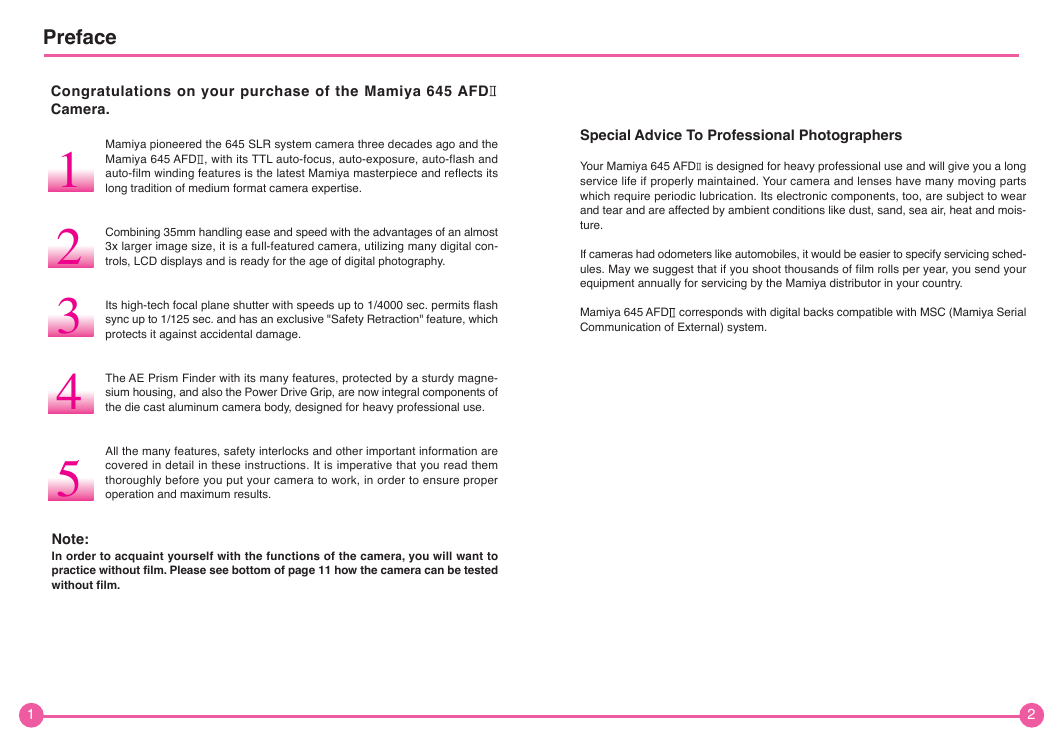
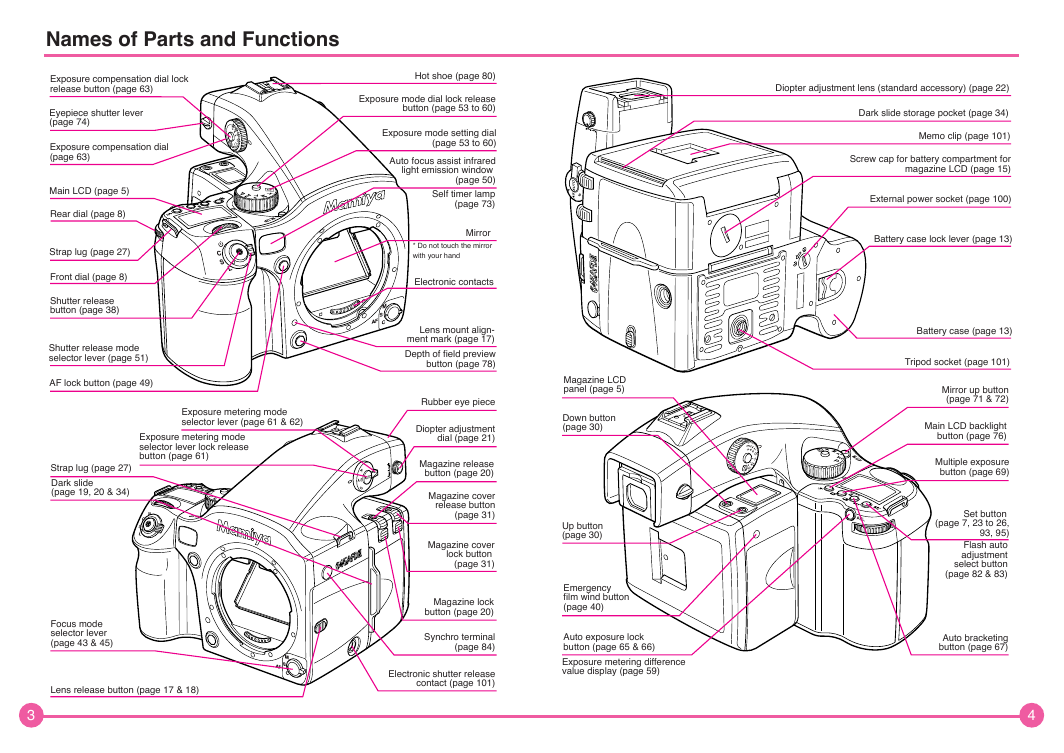
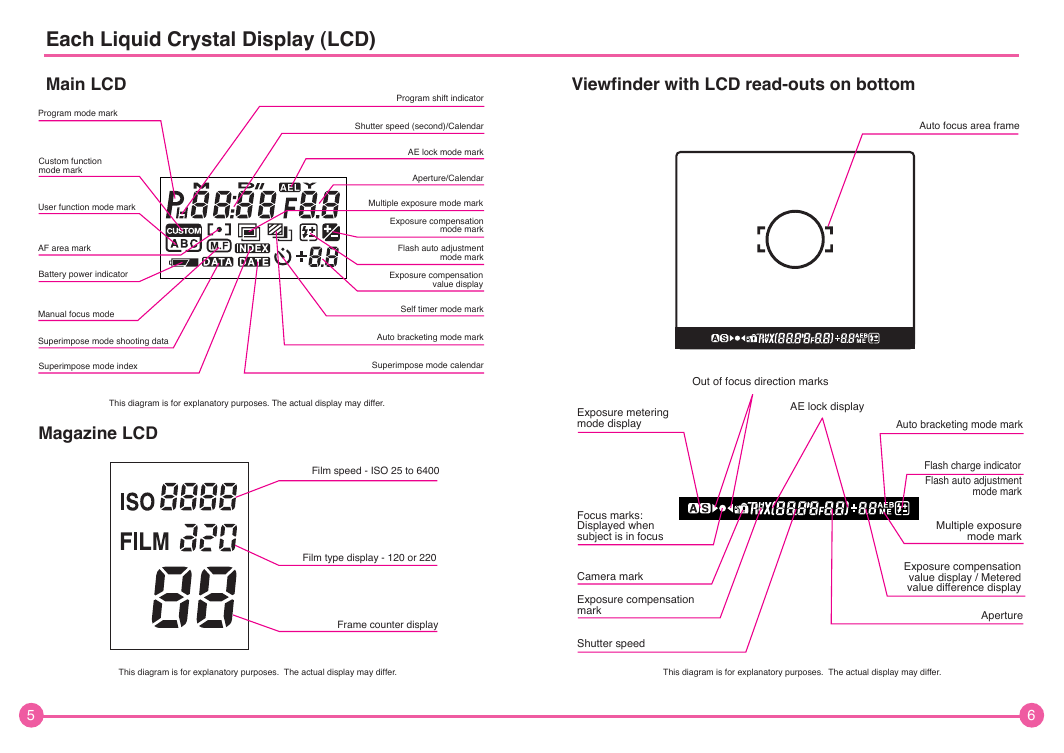


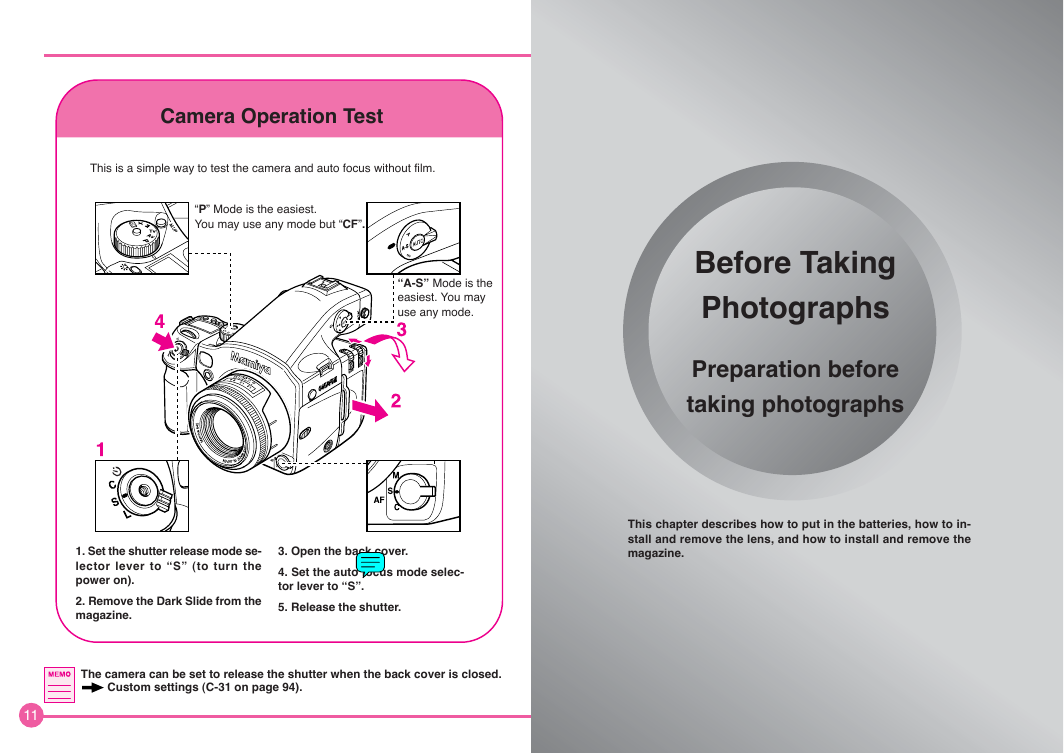
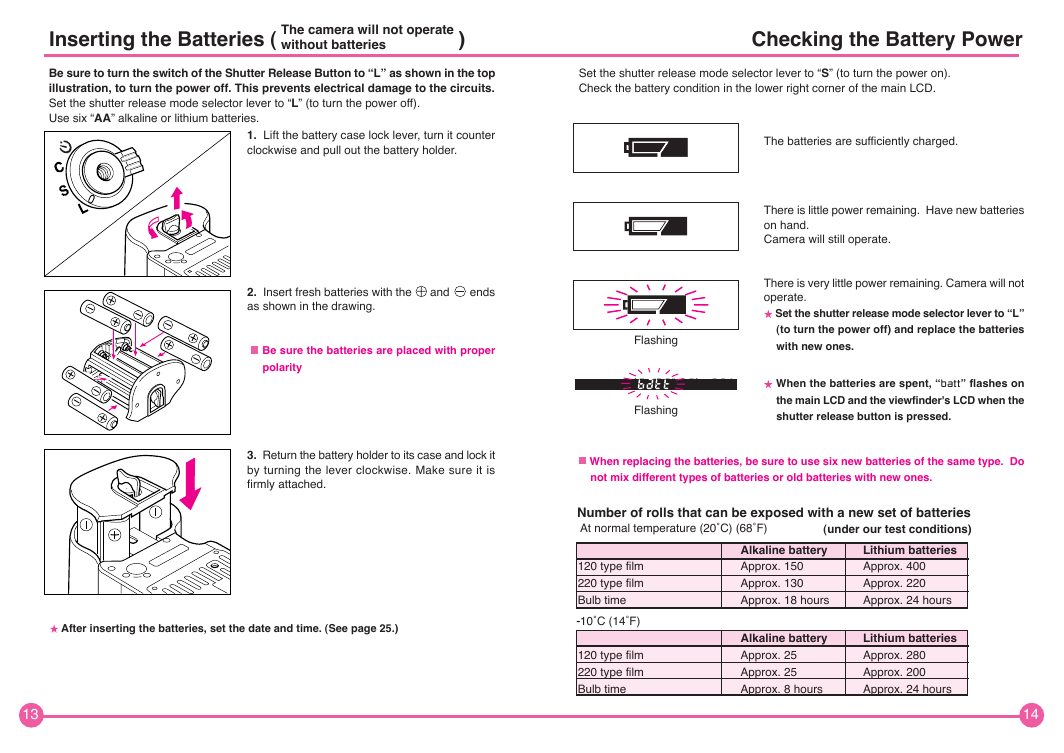









 2023年江西萍乡中考道德与法治真题及答案.doc
2023年江西萍乡中考道德与法治真题及答案.doc 2012年重庆南川中考生物真题及答案.doc
2012年重庆南川中考生物真题及答案.doc 2013年江西师范大学地理学综合及文艺理论基础考研真题.doc
2013年江西师范大学地理学综合及文艺理论基础考研真题.doc 2020年四川甘孜小升初语文真题及答案I卷.doc
2020年四川甘孜小升初语文真题及答案I卷.doc 2020年注册岩土工程师专业基础考试真题及答案.doc
2020年注册岩土工程师专业基础考试真题及答案.doc 2023-2024学年福建省厦门市九年级上学期数学月考试题及答案.doc
2023-2024学年福建省厦门市九年级上学期数学月考试题及答案.doc 2021-2022学年辽宁省沈阳市大东区九年级上学期语文期末试题及答案.doc
2021-2022学年辽宁省沈阳市大东区九年级上学期语文期末试题及答案.doc 2022-2023学年北京东城区初三第一学期物理期末试卷及答案.doc
2022-2023学年北京东城区初三第一学期物理期末试卷及答案.doc 2018上半年江西教师资格初中地理学科知识与教学能力真题及答案.doc
2018上半年江西教师资格初中地理学科知识与教学能力真题及答案.doc 2012年河北国家公务员申论考试真题及答案-省级.doc
2012年河北国家公务员申论考试真题及答案-省级.doc 2020-2021学年江苏省扬州市江都区邵樊片九年级上学期数学第一次质量检测试题及答案.doc
2020-2021学年江苏省扬州市江都区邵樊片九年级上学期数学第一次质量检测试题及答案.doc 2022下半年黑龙江教师资格证中学综合素质真题及答案.doc
2022下半年黑龙江教师资格证中学综合素质真题及答案.doc